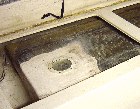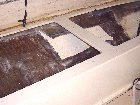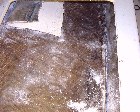
|
The port water tank as installed. The fill and vent hoses are disconnected. The tank is made of foberglass and was tabbed to the hull all around the perimiter. There is a gap between the hull and the tank of about 1 to 1-1/2 inches. The empty tank weighs about 45 lbs. The lay-up is woven roving and is from 1/4 to 3/8" thick. Where the tabbing overlaps the edge of the tank it can be 1/2" thick.
|

|
First cuts on the tank. The cutting was done with a dremel and a carbide rotary bit. One bit was used for all the cutting of this tank. They hold up very well. After cutting the section from the top of the tank I noticed the bottom was not flush with the hull and made the small cut-out to inspect. The gap is 1 to 1-1/2 inches.
|

|
Most of the tank is removed here. There is a small section remaining because it's hard to get at the tabbing under the settee framing. There were no supports under the tank, only the tabbing around the edges. Looks line the tank was set on a few small wood blocks to off-set it from the hull and get the top level and then tabbed in all around.
|

|
In this photo you can see the remaining tabbing on the inblard edge of the tank. I could not get into the gap between the tank and settee face so I had to cut from the inside. That meant cutting through the tank wall and the tabing. That was slower but the only way I could get at that tabbing.
|

|
This photo shows the last section of the tank. It gives a fair idea of the construction of the tank and the way it was tabbed to the hull. Note how thick the tank wall + tabbing gets at the outboard edge. The dremel did a giid job of cutting through this but it is not a tidy tool. But the dust can be contained by holding the vacuum nozel adjacent to the cutting but as you go along. The dremel is not quite as fast as the cutting wheel equipped grinder (seen in photo two above) but it is a lot less messy. The Vacuum is a not capable of keeping up with the dust from the grinder.
|
The empty locker space under the settees is 77 inches long. The aft face is 14" high, 31" deep and forward is 13 high, 22 deep. Taking the hull to be flat here (is is concave) and 75 inches long the volume of the lokcer space is about 7.8 cubic feet or 57 gallons. It would be a little more accounting for the concave curve of the hull.

